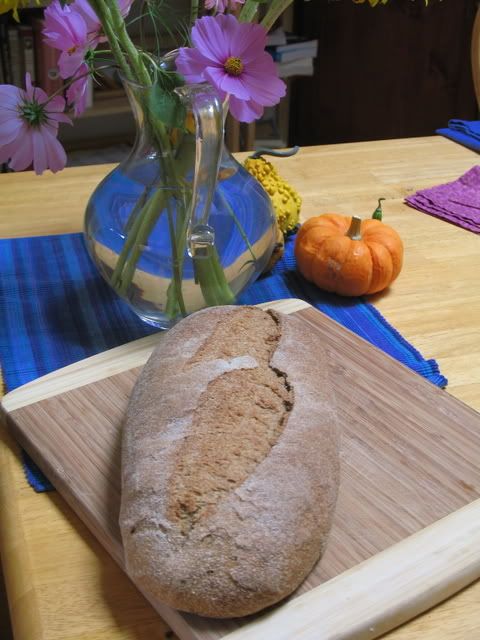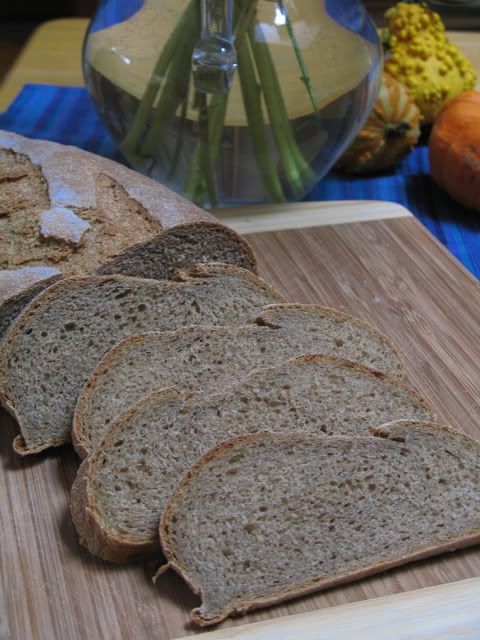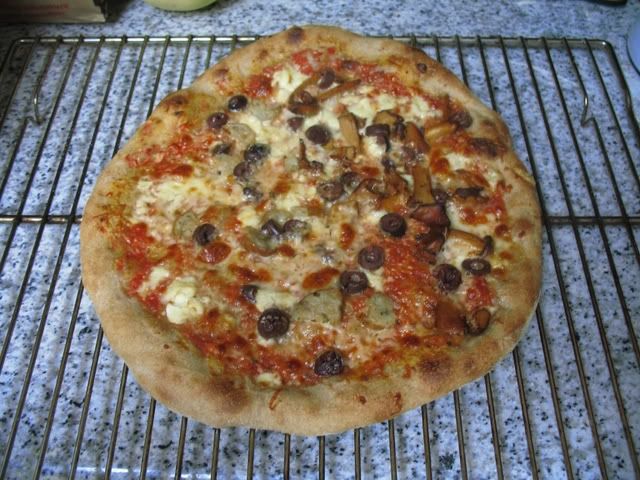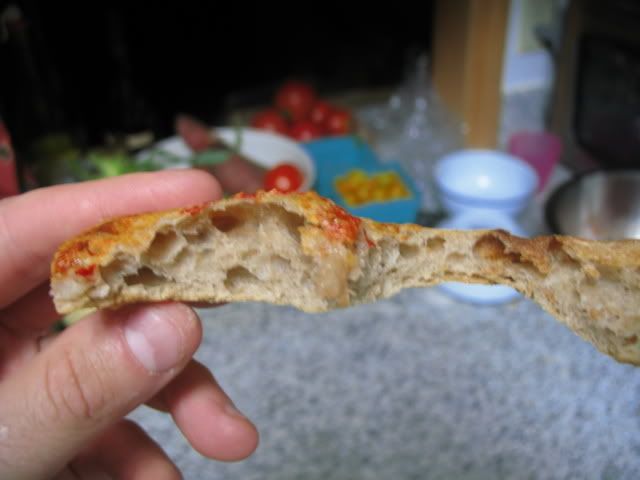
Baking this week
Working from home has its disadvantages: it's all too easy to blur work into home-life, you're somewhat isolated from co-workers, and it's tempting to try to do chores when work is slow.
But bread baking poses no problems at all. Most of bread baking, especially when you use the stretch and fold method to develop dough instead of traditional kneading, consists of 2-3 minute bursts of activity separated by long periods of waiting. The trouble, of course, is that the timing of those little bursts of activity is really, really important. Working from home, the kitchen is always just a few steps away from my computer, and doing the work of making bread takes about as much time as going to fetch a fresh cup of coffee.
Lately, I've been doing a lot of sourdough baking, even when the bread itself isn't truly a sourdough bread. For instance, here's my results from baking Peter Reinhart's Mash Bread, from his new (and fabulous) book, Peter Reinhart's Whole Grain Breads. 

The sweetness of the bread was really surprising, and I was astonished by how much oven spring I got. It's easily the best I've ever gotten from a 100% whole grain bread. Unfortunately, I was in a hurry and didn't let the sourdough mature fully, so the flavor was less than I'd expected. In short, sweet, but bland. I'm eager to try it again, though, and next time I'll let the sourdough fully ripen, which is especially important, since the sourdough is used almost exclusively for flavoring rather than leavening. If you want to make this bread, I'd suggest heading over to Bill Wraith's excellent write-up.
I had some starter left over, so I made up some sourdough pizza dough -- two of the doughballs went in the freezer, while the others went into the fridge so that I could make them up for dinner the next night. Probably two of the best pizzas I've made. A woman at the Corvallis Farmer's Market was selling wild chantrelle mushrooms, so I got some, sauteed them in a bit of butter, and plopped them on the pizza. They were great, along with some black olives and turkey-chicken sausage:
The crust was nice and holey!

Here's how I made it:
Formula
- Whole wheat flour: 50%
- AP flour: 50%
- Water: 80%
- Salt: 2%
- Olive oil: 5%
- 15% of the flour is pre-fermented as starter
- Whole wheat starter (75% hydration): 100 grams
- Whole wheat flour: 130 grams
- AP flour: 180 grams
- Water: 250 grams
- Olive oil: 18 grams
- Salt: 7 grams
Mix the water and the starter, and mush it all up with your fingers until it's a soupy mess. Add the salt and the oil, mix again, and then add the flour. Let it sit, covered, for 1 hour and then give it a stretch and fold. Do two more folds spaced 30 minutes to an hour apart. Let it ferment a total of 4-5 hours at room temperature (about 68-70 degrees F), and then divide into two. Shape each lump of dough into a tight ball, pop them into plastic bags, and put them in the fridge if you plan to use within the next 3 days. Otherwise, put them in the freezer, where they'll keep for at least one month. When you're ready to make the pizza, let the dough sit out for about 2 hours if it was in the fridge, 4 hours if in the freezer. Shape, top and bake on a stone preheated for about an hour in an oven at the highest setting possible. Bake for 8-10 minutes.
Last, my standby: whole wheat sourdough sandwich bread.

Always tasty, always reliable.
Next on my agenda: some of those potato-onion-rye rolls from Peter's book!


Comments
As usual you did a great job. The mash bread is one I want to try. That pizza crust is perfect.
I'd like to ask... which recipe do you use now for your whole wheat sourdough sandwich bread shown above. Do you use your version of PR's bread or now that you have his book do you follow his recipe exactly? weavershouse
I basically make Reinhart's bread when I'm using commercial yeast, but for sourdough, I use this recipe:
- Whole wheat flour: 100%
- Water: 85%
- Salt: 2%
- Butter: 3%
- Honey: 7%
- 30% of the flour is pre-fermented in the starter
For a single loaf, the recipe looks like this:- Starter (75% hydration, whole wheat): 225 grams
- Whole wheat flour: 300 grams
- Water 265 grams
- Salt: 9 grams
- Butter: 14 grams (1 Tbs)
- Honey: 30 grams (1.5 Tbs)
Sometimes I reduce the honey to 1 Tbs or even leave it out, other times I substitute milk for half or all the liquid.First I add the water to the starter and mush it up well. Then I mix in the salt, melted butter and honey. Last I add the flour and mix it until everything is hydrated. Then I cover the bowl with a plate.
After an hour, I pull it out of the bowl and search for lumps, which I mash with my fingers. Then, I fold it and return it to the bowl. I'll fold it again twice, with 30 to 60 minutes in between each fold.
After 3 to 4.5 hours, depending on the temperature (it's about 63 degrees in my house these days, so I've been letting it go long), I'll preshape it, and then shape it into a loaf, after which I put it in a cooler on an upturned bowl. I throw a cup or two of boiling water in the bottom and close it. After an hour or so, I may add another cup. After 2-2.5 hours, it's usually risen about 3/4" to 1 inch above the rim. Then I slash it down the center, and bake it in an oven (cold start) at 350 degrees F for 50-55 minutes until the center registers at least 190 degrees on a thermometer.
Thanks for your time writing that up. I made a copy because trying to find anything in an older thread is so hard. I've been looking for the ww sandwich loaf you posted just before you got your PR book. It was in among a thread I can't find. I used that recipe and it worked so good that I wanted to use it again. So thanks. weavershouse
I made a copy of that recipe. I try to bookmark interesting recipes until I actually make them, then I usually make a copy in my Bread Recipes Directory.
----------------------------------
Jmonkey – Peter Reinhardt WW sandwich loaf
Here's a recipe I use a lot. It's adapted from Peter Reinhart's new whole grains book. Flour is variable for cups, depending on whether you've got a heavy or a light hand. The dough itself will be fairly soft, but will hang together. You should be able to knead it by hand once it's combined the next morning. If not, add flour 1 Tbs at a time:
Night before
Soaker
Sponge
Mix up the soaker in one container and the sponge in another just until everything is hydrated. Let them sit at room temperature over night.
The next morning
Tear the soaker and the sponge into about a dozen pieces each, and mix them together. Add the salt, yeast, honey and butter. Knead for about 3-4 minutes, adjust the flour if necessary, let it rest 5 minutes, and then knead it again for about a minute. Form it into a ball, cover it, and let it rise for about 1.5 to 2 hours until a wet finger makes an indentation that fills back in only very slowly.
Shape into a loaf and, if desired, roll it in sesame, poppy or other seeds. Place into a pre-greased pan, cover with plastic or a damp towel, and let it rise until it's crowned about 1 inch above the rim in the center -- probably 90 minutes. Slash down the center, if desired, and bake at 350 degrees for 50 to 60 minutes, until the center of the loaf is at least 190 degrees.
I'd misread weavershouse's post and didn't realize there was a request for the earlier recipe. Thanks for posting it!
JMonkey,
Those all look just great.
Bill
JMonkey, everything looks just great. I have been struggling with whole wheat recipes I've made because I have not liked the flour I used. I have used KA traditional and organic whole wheats but they just taste to bitter to me or something just doesn't taste wonderful.
I finally ordered some whole wheat from Heartland Mill because they mill daily so I know it is really fresh. I'm trying to decide what would be the best recipe to begin with to test the flavor and see how it compares. I really want to like it. I've noticed other flours in different brands to have extreme differences so here's hoping.
Anyway, thanks for posting your T&T (tried & true) recipes and that pizza dough does look amazing!
In what follows I describe my experience with soaker plus biga breads based on Peter Reinhart's new whole grain book. The results have been excellent.
Basically, I use various combinations of wheat, spelt, and rye flour. For these 12-hour soaker breads I've included between 2% and 5% rye, all of it in the sourdough culture as my culture is 100% rye with an equal weight of water. I've used 0% and between 15 and 30% whole spelt four. The rest has been some combination of "artisan" white flour, whole wheat flour, and Natural Way Mills' Golden Graham flour. The latter has 1/2 the bran removed according to an e-mail conversation with a a representative of the company. That would make it between 92.5 and 95% extraction hard red spring wheat flour, based on what they told me.
The recipes are all "French breead," only flour, water, and salt. The first several batches put 45% of the bread's total flour in the preferment (biga, I guess) and 45% in the soaker, along with 45% of the salt (in the soaker only) and water equal to the hydration of the bread (usually about 75%). I'd use all or mostly whole grain flour in the soaker if there was to be some white flour in the bread. Any white flour would go in the preferment. I generally use an amount of sourdough culture containing between 15 and 20% of the preferment's total flour. Between six and ten hours of fermentation makes a ripe preferment, it seems.
More recently, following Reinhart's recipe for miche bread, I've used a preferment with 30% of the bread's total flour and a soaker with 60%. For some reason, that seems to produce equally good or even better results.
Anyway, after the soaker has soaked and the preferment has ripened, they get mixed along with the remaining 10% of the flour, 10% of the water, and whatever salt wasn't used in the soaker when the soaker and preferment get blended. About 3 1/2 hours of fermentation once all is mixed seems to be about right.
Then, after shaping and about an hour of proofing, I give the bread six to eight hours of refrigeration. Even with that, the results lack a lot of sourdough tang, though you can tell it hasn't been bakers' yeast at work when you taste the bread.
What's noteworthy about bread made this way is that it's more moist than the same hydration bread would be made by more traditional methods (or at least the methods I used before reading Reinhart's book). The dough is softer and more slack. While this makes each loaf a little more expensive, the resulting bread has a far more fine, soft, chewy crumb. Lot's more little gas cells and fewer really large ones. My usual whole grain bread the old way had dough with 80% hydration. The soaker method version at 75% hydration had similar-feeling dough.
This all worked the same way for a French bread that was all artisan white flour except a little bit of rye in the original culture, equal to about 1.8% of the total flour in the bread.
Everyone works differently. Everyone's kitchen has different temperatures, humidity, and so forth. The times listed in Reinhart's book don't match my experience, but he more or less says you have to be guided by the state of your dough and the taste of your bread. My experience won't be yours, exactly, but I recommend trying this "epoxy" method to see how you may adapt it to your situation and tastes.